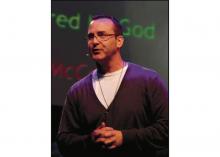When Colin McCartney of Connect City, a church-planting ministry in Toronto, came to Leamington last month, members of five local congregations in Essex County were taken on a journey from Christendom—where the church used to thrive—to post-Christendom—where it is now struggling.
More importantly, he led the group in thinking about how the church might move to a place in the future where it is thriving again.
When looking at where the church is now, McCartney shared a number of statistics that painted a rather bleak picture featuring dwindling attendance and church closures.
For those in church circles, this reality is nothing new. How the broader church has responded to this reality was shown to take four forms:
- Ignore the reality and continue to “do church” in the same old way;
- Become too much like the culture around it and miss its unique calling to point to the kingdom of God;
- Become separate from the world to the extent that it has no meaningful impact on it; and
- Deal with the issue by adopting an “us vs. them” approach, which serves to set non-Christians farther away from the church.
McCartney, who co-founded Connect City, which has planted four churches in the Toronto area, also offered hope for how churches in this time can impact their society today.
Since people are no longer coming to church, “We need to stop thinking, ‘Let’s invite them in.’ They’re not coming. We need to go to them,” he said. “The church is no longer the respected, influential institution it once was. It needs to become a movement, in much the same way as the early church was.”
He pointed to the first-century church, which had no buildings and dwelt on the fringes of society. The fringes are where the church very often finds itself today. McCartney displayed the traits of churches on the fringes that are successful now:
- In these churches, prayer undergirds everything, he said, noting that there are so many examples of Jesus praying in the Bible.
- These churches often have no building. If they do have a building it is used as a hub to send members out to where people in need are. The focus of the church is far from the building. The building is not the church.
- Successful churches in a post-Christendom age are also not reliant on professional clergy. They see themselves more as a priesthood of all believers.
- They are centred on Jesus, as opposed to being centred on a membership list. Churches that are thriving in post-Christendom have dropped the in/out way of thinking about church, which being a member suggests and supports. In the post-Christendom church that McCartney envisions, everyone is on a journey with Jesus.



Add new comment
Canadian Mennonite invites comments and encourages constructive discussion about our content. Actual full names (first and last) are required. Comments are moderated and may be edited. They will not appear online until approved and will be posted during business hours. Some comments may be reproduced in print.